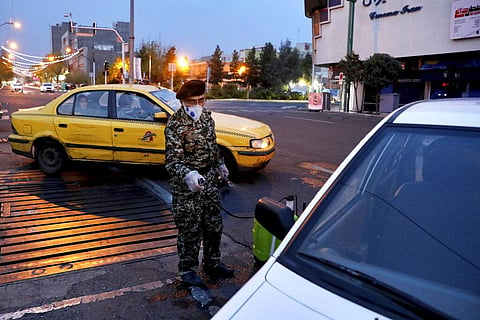

Iran was the first country after China that was ravaged by the coronavirus and for some time, was the second most affected country. Coronavirus cases in Europe and the US have risen rapidly since then. Iran is now eighth on the global list. The virus spread rapidly in Iran in the early stages, though it has now been contained, but not before causing a very high number of deaths of medical workers. Iran remains the worst affected country in the West Asian region, with around 78,000 cases and over 4,850 deaths.
Iran does not share a land border with China. Why did it get affected in the pandemic’s early stages? Heightened rhetoric about a Western plot, quack remedies and faith all added to the problem. On February 19, Iran announced its first confirmed case. During the same month huge rallies were held across Iran to commemorate the 1979 Islamic Revolution. Elections were also held in February with Supreme Leader Ali Khamenei exhorting all Iranians to ignore the virus and come out and vote. There was no attempt at implementing social distancing and President Hassan Rouhani dismissed the virus as “one of the enemy’s plots to bring our country into closure by spreading panic”.
Steps like closing the religious shrines at the holy city of Qom were delayed, causing the virus to spread among pilgrims from Iran and abroad. No quarantine arrangements were declared, though educational institutions were shut down. The Iranian government also revoked permission for Doctors without Borders to set up a field hospital to treat virus-affected patients in Isfahan, apparently on the suspicion that the team of foreign doctors will steal the genomes of the Iranian strain of Covid-19.
The first two victims to die were in Qom, the bastion of Iran’s Shia clergy. It is likely the virus was carried by Iranians returning from China or students from China or Chinese workers engaged in construction of a high-speed rail link. It was also transmitted by pilgrims in Qom thronging Shia religious shrines. The prevailing belief that pilgrims were insulated from the virus did not help. These shrines have since been shut down.
The virus has not spared the high and mighty. It has felled senior clerics, former ambassadors and politicians. A policy of denial has now given way to grudging acceptance that Iran was slow to respond, mistaking the virus as a common flu. Iranians ignored warnings and the government had to impose a countrywide lockdown from the middle of last month and order the security forces, including the Army, to implement the lockdown.
Iran has blamed the US for the debilitating sanctions that have prevented imports of protective gear and medicines. Sanctions have also impeded import of materials for domestic production. Iranian advocates of this argument have called it “medical terrorism”. It is not clear why it could not import medical requirements from China and Russia, both of which have close ties with Iran. The US, which initially ignored appeals for waiver of sanctions, then offered medical and humanitarian aid. But this was predictably rejected by Iran.
After the Trump administration junked the nuclear deal (JCPOA) and reimposed sanctions in 2018, Iran’s oil exports and foreign investment dwindled further. The US has sought to reduce Iran’s oil exports to zero and cripple its principle source of revenue. American sanctions not only prohibited its companies from doing business with Iran but also targeted third-country companies. This led India too to reduce and finally stop oil imports from Iran, which was the third largest supplier in 2019. China, however, disregarding American sanctions, continued to source oil supplies from Iran, bypassing the US dollar.
Economic slowdown and Covid-19 will lead to lower demand for Iranian oil in China and increase pressure on Iran’s revenues even further. From a high of 2.8 million barrels per day, oil production has dropped to 1.4 million barrels per day. Iran’s economy has been effectively crippled with the IMF predicting zero growth in 2020. There has been a surge in unemployment, reserves have plummeted and the currency, Rial, has tanked. Meanwhile, Iran has appealed to the IMF for an emergency loan of $5 billion.
Though American sanctions exclude humanitarian items like medicines and medical equipment, companies have been reluctant to do business with Iran as US banks have avoided financing any humanitarian trade with Iran. The potential Democrat Party presidential challenger to President Trump, Joe Biden, has called for easing US sanctions. He has asked for specific licensing arrangements so that companies find it easier to export medical supplies and banks have no doubt about falling foul of sanctions. As the clamour has grown for international assistance to Iran, European countries like France, Germany and UK have skirted American sanctions with their financial system Intex to provide medical supplies to Iran worth around Euro 5 million.
India has been airlifting Indians stuck in Iran. The IAF has been doing the heavy lifting in bringing back Indians stuck abroad and Air India too has played a stellar role. President Rouhani has written to global leaders, including PM Modi, for help in easing American sanctions and medical supplies. The irony is that just a few weeks ago, Iranian leaders had issued intemperate statements against India on Jammu and Kashmir and the Delhi violence. India has lifted the ban on export of paracetamol and hydroxychloroquine to select countries. Iran too may benefit from this. Iran’s economy, like those of other countries, will take a greater hit from coronavirus than American sanctions in the near future.
Pinak Ranjan Chakravarty
Former Ambassador, Former Secretary in MEA and currently a Visiting Fellow at ORF, Delhi
Email: r.chakravarty@gmail.com